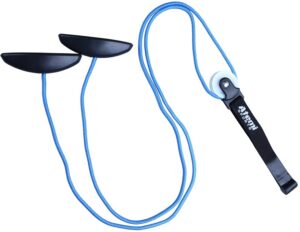How to do Shoulder Impingement Exercises for Treatment at Home

In this post we will show you a series of shoulder impingement exercises you can do at home as an effective treatment for shoulder pain and stiffness.
Doing these exercises will allow you to gradually regain your range of motion, strengthen your rotator cuff, and speed up the healing process.
Exercises for shoulder impingement can be done using a physiotherapy shoulder pulley. Read on to find out more.
What is a Shoulder Impingement?
Often known as tendinitis, tennis shoulder or swimmer’s shoulder, a shoulder impingement happens when the tendons in your shoulder joint become inflamed, causing pain and loss of mobility. It usually takes 3 to 6 months to fully recover, but can take up to a year in severe cases.
Impingements are often caused by playing sports which involve lifting the arm over the head repeatedly. For example, swimming is a common cause of this condition. But they can also be caused simply by sleeping in the wrong position or by bad postural habits which build up over time.
Symptoms of Shoulder Impingement
The symptoms of shoulder impingements can include:
- Pain in the front of your shoulder or the side of your arm
- Swelling and tenderness in the affected areas
- Reduced range of motion of your shoulder joint, especially overhead or behind your back
- A clicking or snapping sound when you move your shoulder
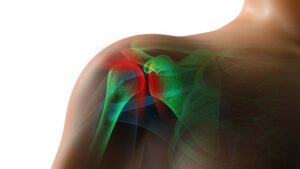
How to do Exercises for Shoulder Impingement
Most shoulder impingements can be treated naturally with physiotherapy exercises, without the need for medication or surgery. After doing the exercises for the required amount of time, most people are able to regain full mobility in their shoulder.
The best physiotherapy tool for shoulder impingement exercises is a shoulder pulley:
The pulley is attached to a door anchor which you can fit to any doorway by wedging it between the door and the frame, like this:
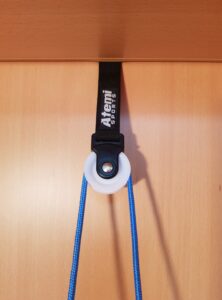
With the pulley anchored securely, you can then perform physiotherapy exercises for an impinged shoulder, as described below.
7 Shoulder Impingement Exercises using a Pulley
Before we look at each exercise in detail, here’s a video from our YouTube channel showing you how to set up and perform shoulder exercises with the pulley:
For shoulder impingements you should aim to do these exercises twice a day with 3-4 sets of 10 repetitions for each exercise. Hold the stretch in the final position for around 10 seconds.
Only move on to the next exercise when you feel comfortable with the previous one. If your range of motion is very limited you should spend several days only doing the first movement before going on to the next. But if your condition is only slight, you might be able to do all the exercises from the outset.
In the below pictures, the left shoulder is the one with the impingement.
Exercise #1

In the first exercise, your chair should face the door square-on, with the door anchor secured at the top of the door. The unimpinged arm pulls the impinged arm, gently stretching it forwards and up. Hold in the final position for 10 seconds and then lower the arm.
Exercise #2
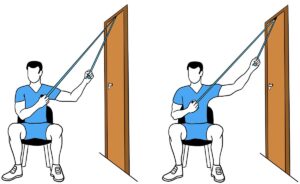
Once you are comfortable with the first shoulder impingement exercise, turn your chair 90 degrees and do the same movement from the side. Gradually let your shoulder stretch and increase its range of motion. Go slowly and listen to your body.
Exercise #3
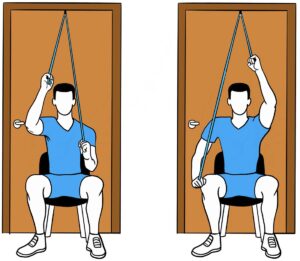
When you feel that your range of motion has improved somewhat, turn your chair so that you’re facing away from the door. Using the unimpinged arm, lift the impinged arm up directly in front of you, holding in the final position for around 10 seconds.
Exercise #4

The next step is to adjust the angle of your arm from your body to 45 degrees. Do the same movement at this angle, stretching the arm as high as you can go without too much pain. Always hold in the final position for around 10 seconds.
Exercise #5
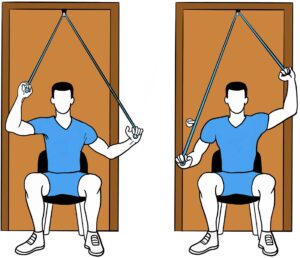
Next, move your arm so that it’s at 90 degrees from your body and do the same exercise in this position, again holding in the final position to let your shoulder stretch out.
Exercise #6
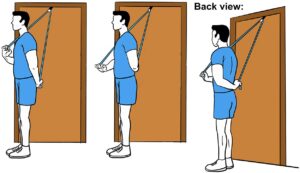
The next exercise is done in a standing position. Lift the injured arm behind your back, as shown above. Start off slowly with only small movements and gradually increase the range of motion.
Exercise #7
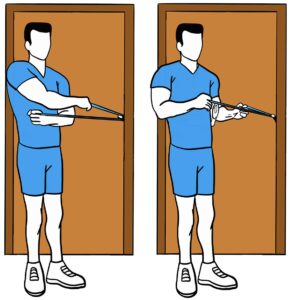
Once your range of motion has increased significantly, you can start doing rotational exercises with the shoulder pulley. Standing side-on to the door, pull the impinged arm so that it is rotating outwards, again holding in the final position and gradually increasing the range of motion.
Do not let your shoulder hunch up or move forward – keep a natural upright posture throughout the movement, and ensure that your elbow is fixed close in to your side. Keeping a folded up towel between your elbow and body can help with this.
Resistance Band Exercises for Shoulder Impingements
Once you’ve completed the full series of shoulder pulley exercises, you can move on to using resistance bands to strengthen your rotator cuff. This will help to maintain shoulder mobility and prevent re-injury.
The best kind of band to use for these exercises is a physiotherapy band:
See our post on shoulder physio exercises to find out about using this band to strengthen and injury-proof your shoulders.
Briefly, to treat and prevent shoulder impingements you need to strengthen your rotator cuff by doing rotational exercises. For example, outward rotations:
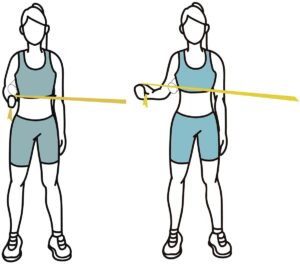
And inward rotations:
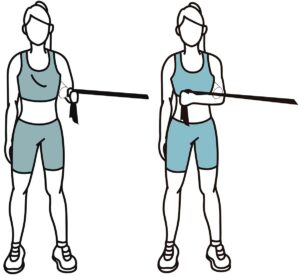
Here’s a short video demonstrating how to do these exercises:

